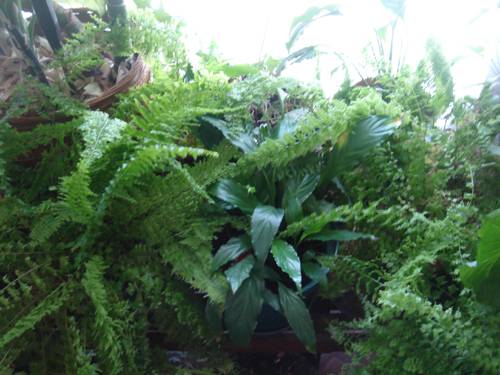
FAQ About Indoor Fern Care and Maintenance

What are the ideal humidity levels for indoor ferns?
Ferns typically thrive in environments with high humidity levels. Ideally, the humidity should be between 50% and 80% for most fern species. If your home is dry, especially during winter, consider using a humidifier or placing your ferns on a tray filled with water and pebbles to increase humidity.

How much light do indoor ferns need?
Indoor ferns generally prefer indirect light. Too much direct sunlight can scorch their leaves, while too little light can hinder their growth. Place your ferns near a north or east-facing window for optimal conditions, or use sheer curtains to diffuse direct sunlight.

What type of soil is best suited for indoor ferns?
Ferns require soil that is rich in organic matter, well-draining, and slightly acidic. A good potting mix for ferns might include a combination of peat moss, pine bark, and perlite or vermiculite to ensure proper drainage and moisture retention.

How often should I water my indoor ferns?
Watering frequency will depend on the specific fern species and indoor climate conditions. Generally, it's important to keep the soil consistently moist but not waterlogged. Check the top inch of soil – if it feels dry, it's time to water.

Can indoor ferns survive in low-light conditions?
While many ferns can tolerate low-light conditions, they may not grow as quickly or lushly as in more favorable light situations. Species like the Boston fern or maidenhair fern are more adaptable to low-light environments.

What are common pests that affect indoor ferns?
Common pests that can affect indoor ferns include spider mites, aphids, and scale insects. Regularly inspect your plants for signs of infestation, such as discolored leaves or webbing, and treat them promptly with insecticidal soap or neem oil if needed.

How can I increase humidity around my indoor ferns?
To increase humidity, you can group your ferns together, mist them with water regularly, use a pebble tray with water, or run a humidifier in the room. Increasing humidity not only helps the ferns thrive but can also prevent issues like browning leaf tips.

What temperature range is ideal for growing indoor ferns?
Indoor ferns prefer temperatures ranging from 60°F to 75°F (15°C to 24°C). They are sensitive to cold drafts and sudden temperature changes, so it's important to keep them away from windows or doors that may expose them to sudden cold air.

How do I fertilize indoor ferns for optimal growth?
Ferns do not require heavy fertilization. During the growing season (spring and summer), a balanced, diluted liquid fertilizer applied once a month is usually sufficient. Avoid fertilizing during the winter months when the ferns are not actively growing.

What should I do if my fern's leaves are turning brown?
If your fern's leaves are turning brown, it could be due to low humidity, too much direct sunlight, or underwatering. First, check the humidity levels and increase them if necessary. Ensure the plant is not in direct sunlight and check if the soil is staying adequately moist.

Can ferns be propagated indoors, and how?
Yes, many ferns can be propagated by division or spores. Division involves separating a healthy plant into smaller sections, each with its roots and fronds, and potting them separately. Propagating by spores requires patience and involves collecting spores from mature fern fronds and nurturing them in appropriate conditions.

How can I protect my indoor ferns from cold drafts?
To protect indoor ferns from cold drafts, place your plants away from exterior doors, windows, and vents that may bring in cold air. Consider moving them to a warmer, more stable environment if they are currently exposed to fluctuating temperatures.

Why are my indoor ferns losing leaves?
Losing leaves can be a sign of stress for indoor ferns, often caused by low humidity, inconsistent watering, or insufficient light. Evaluate the care conditions, such as humidity and light levels, and adjust your watering routine to ensure the plant's needs are being met.

What are some types of ferns that are suitable for indoor growing?
Many fern species are suitable for indoor growing, including Boston ferns, maidenhair ferns, staghorn ferns, and bird's nest ferns. Each variety has its own care requirements, but generally, all enjoy humid environments and indirect light.

Can I grow ferns in a terrarium, and what should I consider?
Yes, ferns can thrive in a terrarium due to the high humidity levels they need. When setting up a terrarium for ferns, ensure there is adequate air circulation to prevent mold growth and choose a well-draining soil mix to avoid waterlogging.

How do I prune my indoor ferns?
Pruning is an essential part of indoor fern care to remove dead or damaged fronds, promote healthy growth, and maintain a tidy appearance. Use sharp, clean scissors or pruning shears to cut off the unwanted fronds at the base, being careful not to damage any new growth.

What signs indicate overwatering of my indoor ferns?
Signs of overwatering include yellowing leaves, wilting, or root rot. If you suspect overwatering, check the soil for excess moisture and ensure your pot has adequate drainage. Reduce watering and allow the soil to dry out slightly between waterings.

Do indoor ferns require repotting, and when should this be done?
Ferns typically require repotting every 1-2 years as they outgrow their current containers. Early spring is the best time to repot, as this is when ferns enter their active growth phase. Choose a slightly larger pot and fresh soil to give the roots more room to expand.

How can I remove dust from the leaves of my indoor ferns?
Dust can be gently removed from fern leaves by using a soft cloth or sponge dampened with water. Alternatively, you can gently rinse the leaves with lukewarm water in the shower or sink, ensuring you support the fronds to avoid damage.

Are there any indoor ferns that are safe for pets?
Several indoor ferns are non-toxic to pets, including the Boston fern, rabbit's foot fern, and maidenhair fern. However, it's always a good practice to verify if a specific plant species is safe for your pets and keep all plants out of reach of curious animals.
